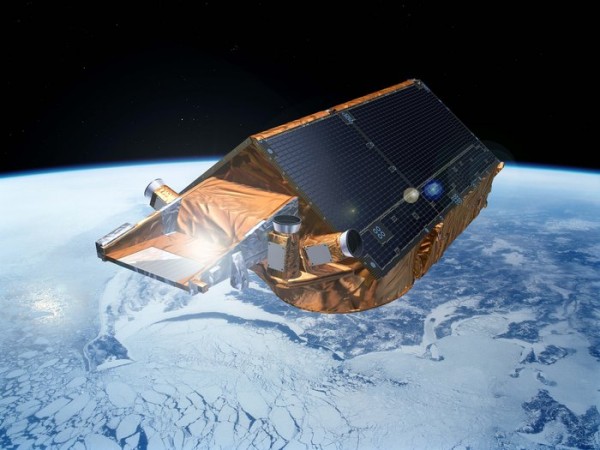3D CryoSat Data Reveals Arctic Sea Ice Thickness at Highest Level in Recent Years
| Ana Verayo | | Apr 20, 2015 07:22 AM EDT |
(Photo : ESA – P. Carril) The CryoSat mission provides data to determine the precise rate of change in the thickness of the polar ice sheets and floating sea ice.
Prior studies revealed that Arctic sea ice was at its lowest level ever last winter. New data, however, reveals sea ice volume in the Arctic appears to say otherwise.
The European Space Agency's CryoSat spacecraft's job is to monitor and survey the thickness of ice floes, especially in the far North Pole. To date, the thinnest winter ice ever recorded was observed in 2013. This February, however, Arctic ice sheets were 25 centimeters thicker than normal, which is a 17 percent increase.
Like Us on Facebook
The CryoSat team says that even if this year's ice floe thickness seemed to increase, the long-term trend is still downwards. Every year, numbers remain inconsistent and it just happens that there have been relatively high levels of Arctic sea ice volume and thickness over the last few years, according to Rachel Tilling of the UK's Nerc Centre for Polar Observation and Modelling.
Tilling adds sea ice volume is the number people should watch since it's the most reliable measurement of how much ice is left. This is also pivotal for scientists to understand the processes that could have caused the climate in the Arctic to change. This understanding could lead to better climate models of sea ice in the future.
The winter sea ice in the Arctic reached a maximum this February 25 at 14.54 million square kilometers. This is still a two dimensional view of the Arctic where winds cans still spread out ice floes and even pile them up sometimes.
CryoSat's mission is to capture the other aspect of the Arctic ice system, the 3D aspect, by measuring thickness and detecting the height of the ice exposed above the Arctic Ocean. When these two datasets are combined, it will allow scientists to compute for changes in the sea ice volume.
This year, CryoSat measured sea ice floe thickness of over 1.7 meters, giving a volume across the Arctic of 24,000 cubic kilometers. In 2013, rapid melting from the previous summer caused that year's winter ice floe thickness to average 1.5 meters and volume decreased to below 21,000 cubic kilometers.
The team goes through a painstaking process of consolidating data from thickness and volume numbers obtained by the satellite. Now, scientists are able to produce results faster and also provide a real time service to aid science missions and maritime activities.
According to CryoSat mission manager, Tommaso Parrinello, this timely pan-Arctic knowledge of sea ice volume available throughout the year is now a priority for operational and forecasting services due to the ice melting. Shipping companies can benefit from this information to sail safely in Arctic latitudes, he adds.
TagsESA, CryoSat, 3D CryoSat Data Reveals Arctic Sea Ice Thickness at Highest Level in Recent Years, arctic ice sea levels, Arctic sea ice floes, Arctic
©2015 Chinatopix All rights reserved. Do not reproduce without permission
EDITOR'S PICKS
-

Did the Trump administration just announce plans for a trade war with ‘hostile’ China and Russia?
-

US Senate passes Taiwan travel bill slammed by China
-

As Yan Sihong’s family grieves, here are other Chinese students who went missing abroad. Some have never been found
-

Beijing blasts Western critics who ‘smear China’ with the term sharp power
-

China Envoy Seeks to Defuse Tensions With U.S. as a Trade War Brews
-

Singapore's Deputy PM Provides Bitcoin Vote of Confidence Amid China's Blanket Bans
-

China warns investors over risks in overseas virtual currency trading
-

Chinese government most trustworthy: survey
-

Kashima Antlers On Course For Back-To-Back Titles
MOST POPULAR
LATEST NEWS
Zhou Yongkang: China's Former Security Chief Sentenced to Life in Prison

China's former Chief of the Ministry of Public Security, Zhou Yongkang, has been given a life sentence after he was found guilty of abusing his office, bribery and deliberately ... Full Article
TRENDING STORY

China Pork Prices Expected to Stabilize As The Supplies Recover

Elephone P9000 Smartphone is now on Sale on Amazon India

There's a Big Chance Cliffhangers Won't Still Be Resolved When Grey's Anatomy Season 13 Returns

Supreme Court Ruled on Samsung vs Apple Dispute for Patent Infringement

Microsoft Surface Pro 5 Rumors and Release Date: What is the Latest?










